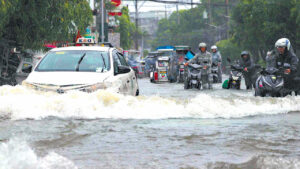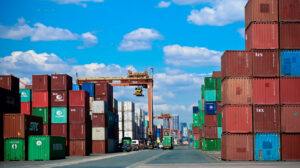IT WAS ONE absolutely wet and windy stretch. Two weeks or so ago, we were assaulted with about five consecutive typhoons in and around the Philippine area of responsibility, a deluge of monsoon rains, and almost 10 days of gray storm clouds — all adding up to an exceptional drenching for the Luzon and Metro Manila areas.
Of course, with the non-stop rains came the inevitable floods. And, as President Ferdinand R. Marcos, Jr. pointedly called out in his third State of the Nation Address (SONA) recently, “Mahiya naman kayo (Have some shame),” referring to possible lapses and irregularities in the government’s flood control projects. He rued the lack of maintenance leading to collapsed, ill-designed infrastructure, and sub-standard work and materials (“palpak” or badly done) as evidence of incompetence and dubious or ghost (“guni-guni”) contracts. Truly, the recurring — even worsening — state of flooding in the country is lamentable and worrisome. It is a clear case of throwing good money after bad, year after year after year — not to mention the adverse impact to economic activity and the daily life of innumerable Filipinos.
According to a study published by Global Climate Risks in February 2025, the Philippines suffers an annual economic loss of US$500 million to US$625 million from flooding — cited as the second-most frequently occurring hazard after storms. This is despite the stupefying increases in the flood mitigation budget of the Department of Public Works and Highways (DPWH). In 2015, the budget was P42.2 billion; in 2024 this rose to P244.5 billion. This year, the DPWH allocated P254.29 billion for its flood management program. Some estimates place spending on flood control projects at P1.2 trillion from 2009 to 2024. That comes to around P80 billion a year over the past 15 years or about P220 million a day. And yet the rise in flood waters continue unimpeded whenever the rains come.
While these might all sound very alarming at the macro level, I can only imagine that the reality on the ground in flood-prone areas must be simply and utterly devastating. To live in constant fear of waters rising — at times up to rooftops — or to be constantly ready to evacuate at a moment’s notice or to lose property and lives is not something that anyone should have to endure. It is truly a tragedy when Filipinos simply must resign themselves to living with this sorry state of public service.
With the pronouncements of President Marcos, Jr. in his SONA, hope of improvements — if not a serious attempt at the eradication of floods — rise on the horizon. It is probably too much to expect a “one-time-big-time” win in the battle against flooding. Streamlining and intense scrutiny of projects will be key. However, equally as important will be for the people to do their part.
We have to take waste disposal seriously. Blockage of sewage and drainage canals by garbage (including so much plastic) — is as much a culprit of flooding as the lack of infrastructure. We need to be more responsible in managing and, as importantly, creating waste. Local government units (LGUs) can spearhead educational programs and a more systematic approach to waste management. Nothing short of a nationwide effort is needed to succeed in this battle.
As rising waters circled the metropolis, nearby cities, and rained-out areas, social media were also flooded with reports of motoring incidents. Photos and updates of street flooding were rampant. The inevitable videos of cars powering through flooded thoroughfares filled the cyber-highways. The usual reels of the tough guys — pickups and SUVs — were totally compelling. But amazing videos of even smaller vehicles of the subcompact kind filled SocMed channels as well. It came to the point, though, that some of the playbacks caused a suspension of disbelief. True or fake? With the enhanced capabilities of mobile apps, online software and artificial intelligence, the lines between reality and sheer imagination have become completely blurred.
In my mind, posting these “brave” crossings across flooded roads are as dangerous as they are informative; fake ones are just outright irresponsible. These videos could give drivers-at-large a false sense of security when faced by floodwaters. They can fall prey to the “anything they can do, I can do better,” syndrome.
First of all, driving through floods must be avoided as much as possible, especially in waters that rise halfway above the wheels or above the floorboard. Cars were designed to run on land, not in water. With all the on-board circuitry that modern vehicles carry, the possibility of stalling is that much higher than in mechanical technologies of earlier generations. Internal combustion engines (ICE) stall when water enters the engine’s air intake, interfering with the combustion process. In newer technologies, there is the added and higher risk of short circuits in electrical systems due to water damage. And it pays to remember that electrical repairs or parts replacement — like, for example, the electronic control unit (ECU) — can make a big dent on your pocket.
Navigating through high waters requires skill and an elevated level of mastery of the vehicle. Safety to yourself and others on the road — pedestrians and vehicles alike — trumps everything else. If you find yourself in a flooded area, it might be best to find a safe place to park and wait for the waters to recede. If you are caught in traffic and the waters keep rising, better to get out of the car before the inundation traps you inside. There is no shame in being cautious and keeping your wits about you. Of course, having an emergency pack on board — with the likes of bottled water, light snacks, first aid items, an umbrella or raincoat — is always advisable.
The advent of electrified vehicles (xEVs) leads to even more escalated cautionary action. To be sure, anxiety about batteries getting immersed in water is not uncommon. Of course, xEVs were designed with the prospect of having to traverse floods in mind. But, like their ICE-powered cousins, they are aimed at covering only short distances and specific water levels — particularly in exceptional or emergency situations only. The same conventional wisdom of avoiding driving through high waters should prevail.
At the end of the day, it is better to be safe than sorry. When in doubt, err on the side of caution. Safe motoring, everyone.






